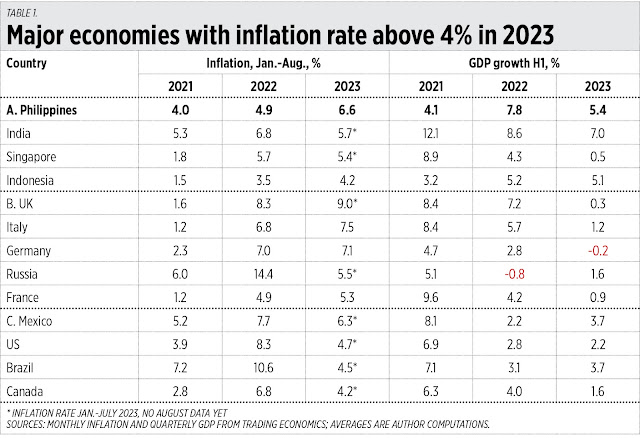High inflation with high growth, the case of the Philippines, Indonesia and India
September 7, 2023 | 12:02 am
My Cup Of Liberty
By Bienvenido S. Oplas, Jr.
https://www.bworldonline.com/opinion/2023/09/07/544051/high-inflation-with-high-growth-the-case-of-the-philippines-indonesia-and-india/
One concept or theory in economics related to inflation and growth is the Philips Curve. It says that there is an inverse relationship between inflation and unemployment, so high inflation leads to low unemployment and, by extension, high growth because high growth leads to more job creation and hence, low unemployment.
This is not a rock-solid economic law or theory, unlike the law of supply and demand and price movement, and the law of diminishing marginal utility or revenue, with almost 100% accuracy and predictability. But somehow the Philips Curve theory seems to apply in the current situation of the Philippines, Indonesia, and India.
The Philippine Statistics Authority (PSA) reported last Wednesday that the country’s inflation rate is 5.3% — breaking six months streak of continued decline in inflation, which was only 4.7% last July.
I construct a table showing the inflation rate and growth rate of major economies in the world, focusing on countries with inflation of 4% or higher in 2023.
Among Group A (Asian countries), the Philippines has the highest average inflation rate this year with 6.6%, followed by India and Indonesia. The three countries are also in the top five of a list of the fastest growing countries among the top 50 largest economies in the world by GDP size, in the first half (H1) of 2023. The other two countries in the top five were the United Arab Emirates at 8.5%, and China at 5.4%.
Singapore has escaped the Philips Curve theory — it has high inflation with low growth. As did the Group B countries (Europe), especially the United Kingdom and Germany which had inflation rates of 9% and 7.1%, and growth of 0.3% and -0.2%, respectively.
Group C — the biggest economies of North and South America — also had high inflation but with modest growth, higher than Europe but lower than the Asians (see Table 1).
So, the high inflation in the Philippines, Indonesia, and India has not cooled down domestic consumption nor production by various sectors. Their huge populations have created dynamic domestic economies that continue to grow despite the worsening global economic environment.
While continued high inflation is bad news in the Philippines, high growth in H1 is good news. And from the PSA data, the main contributors to the 5.3% inflation in August were Alcoholic beverages and tobacco (10.1%), Food and non-alcoholic beverages (8.1%), and Restaurants and accommodation services (7.1%). This implies that many people are going out more: partying, drinking, smoking, and going to restaurants, hotels, and resorts. Which creates more jobs in the services sector.
Jobs creation should continue, be sustained and expanded. So long as people have jobs, they can adjust to rising prices.
The rise in inflation in August coincided with a slow rise in the global prices of oil as OPEC and Russia have cut their production and exports.
In Table 2 is a comparison of the global prices of some important commodities six months apart over the last two years. One can see that oil prices increased in August this year, but these are similar to levels from a year ago. Coal prices have increased slightly, but these are still low compared to prices in January to May this year, and previous months.
Rice prices are not rising fast as predicted by food crisis alarmists due to the current El Niño season and rice export ban by India. Current rice prices are similar to those of a year ago. Corn and wheat prices now are lower than the past two years (see Table 2).
So we should not entertain the alarmist narrative of further rising inflation. Prices are still in their natural modest fluctuation, not on a severe upward or continuously rising trend.
The government can help by cutting food imports tariffs and revive free trade policy especially in food. And the public should continue to do more productive work and be less alarmist, and lobby less for additional food and cash subsidies. If we want cheaper food and other commodities, we should expand food production, move towards more corporate farming and land consolidation with economies of scale. More political accommodations via subsidies that will require more taxation and borrowings will only worsen, not improve, the high inflation problem.
------------
See also:
BWorld 634, BRICS energy and Philippine hosting of FIBA games, Sept. 16, 2023
BWorld 635, Financing Growth: reforms in government procurement, MUP pension, and infrastructure, Sept. 17, 2023
BWorld 636, Economic basis of net zero is zero, September 18, 2023.


No comments:
Post a Comment